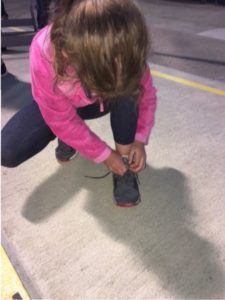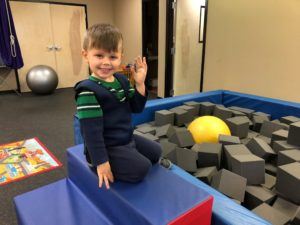Month: June 2017
Raising a confident child is the goal of every parent. Confidence often trumps intelligence as being sure of yourself can take your far in life and mask what is lacking in intellect.
Instilling confidence starts at an early age.
When your child is an infant, allow multiple people to hold and talk to your baby. This encourages your child to feel safe even when they are not with you and know that you will return when you hold them again. This same premise continues as your child gets older. Be sure to allow your child to spend time away from you completely. Maybe a playdate with grandma or a babysitter will allow you to go grocery shopping or on a date with your significant other. This builds your child’s confidence. Your child will need to rely on themselves gaining confidence from within versus getting confidence from you, the parent. Consider when you are on a playdate with your child to sit a distance away from them. If you child seeks you out for help, talk the solution through with your child but send your child to handle the situation without you. Asking open ended questions like “what do you think you should do?” or “how do you think you should handle it?” will guide your child to be a confident, problem solver.
As your child experiments with walking, let him/her fall. These will not be big falls as he/she is quite small. You can “let” your child fall on carpet just allow your child to make mistakes so they have the ability to learn from them.
As your child grows, set up their space to allow for independence. Put up a hook low enough for them to hang their own coat. Shoes cubbies teach a child to put away their shoes. A hook in the bathroom allows them to hang their towel if they cannot reach the towel bar. Encourage your child to put away their toys. A step ladder at the sink allows them to help with dishes. Confidence grows in the ability to do more tasks on your own.
Dress and undressing themselves allows children to feel confident with their own bodies. Be aware of the correct ages to encourage each dressing and undressing task. As the parent you will have to buy clothes that allow for this learning and independence. For example, elastic waist pants are easier to put on than button waist pants. Shirts that pull over the head are easier to put on than shirts with multiple buttons.
A child should be able to tie their own shoes by the age of 5. So he/she should start wearing tie shoes around the age of 4 years old so they can begin to practice tying.
Biking riding is a social skill. Children that do not learn how to ride a bike may be left behind when their friends ride off on their bikes. So make sure you really work on this with your child. Know what age your child should ride a bike without pedals progressing to a tricycle to a 3 wheeled scooter to a 2 wheeler with training wheels and a 2 wheeled scooter to a bike without training wheels. Much confidence and independence is developed with bike skills.
Children often exhibit behavior due to lack of verbal skills. So encourage language in your child early. Read books and name each picture in the book. Name each item in your child’s environment. Be sure to vary your vocabulary. For example, rather than calling all shoes shoes use the more specific names like sandal, slipper, heel, flip flop, etc. Read books with real animals rather than cartoon pictures. Cartoon horses can look the same as a cartoon cow, dog or goat.
Visit our website at https://www.abcpediatrictherapy.com for developmental checklists so you know what to encourage with your child and when. Look ahead so you are sure to have the correct toys in your home at the correct time.
Good luck! I believe you can raise a confident, successful child.
Infant Developmental Tips:
*Limit the use of positioning devices such as swings and bouncers. Too much time in these devices can lead to a mishappen head and delays in development. Place your infant on their tummy to play several times throughout the day. Avoid the use of walkers, the rock and play Sleeper and Bumbo Seat for safety and developmental reasons.
*When your child is ready to transition to baby food, let them get messy and feel the food on their face, lips, and hands.
*To aide in feeding and speech development, use an open cup, straw cup, or non-spill open cup instead of a hard spout sippie cup.
*When your infant starts walking and through the toddler years, have them wear closed toed supportive gym shoes, no sandals or flip flops.
*Talk to your baby. Read to your baby.
Nutrition:
*Offer your child a variety of foods with different flavors, textures, and temperatures.
*Do not allow them to graze throughout the day.
*Do not insist they clean their plate. They know when they are full.
Let Them Play and Explore
*Children learn to do new things through exposure to new things.
*Keep them active! Limit time spent watching TV or on electronic devices. Children under the age of 2 should not have any screen time. Children ages 2-5 should be limited to 30 minutes per day and children over 5 no more than 2 hours per day (per AAP).
*Let them create their own crafts. When we take over their project, we are telling them that we can do it better.
*Let them get messy!
Behavior
*Be consistent with discipline and expectations. Be sure the expectations are appropriate for the age of your child.
*Make sure your child has the language to express their wants and needs
W – Sitting
W – sitting is when a child sits on the floor with their bottom touching the ground and their feet out to the side of them while their knees are bent. Too much time spent in this position can cause your child to walk pigeon toed.
Encourage Independence
*Teach them how to zip their own coat and tie their own shoes. Tie shoes should be purchased when your child is 4-5 years old, as the skill should be mastered when they are 5.
*Place items in your house where they can reach them. For example, install hooks in your closet so they can hang their own coat.
If you have a concern regarding your child, do not wait! Children grow up fast! Share your concerns with your child’s pediatrician right away. ABC can help evaluate the concerns and teach you to teach your child! Visit us at https://www.abcpediatrictherapy.com for more tips and tricks.
Read More
Here are some great tips to help improve your child’s handwriting:
1. Use a finger to space out your words if you are having difficulty with word spacing.
2. Participate in hand strengthening activities to increase hand strength and endurance. Some ideas of hand strengthening activities include: using theraputty and finding small objects hidden in it; or squeezing open a tennis ball with a slit cut in it to put small items inside (pictured below).

3. Practice appropriate letter formation by writing letters in shaving cream, pudding, sand, or other material. Using a variety of media to form letters can make writing more fun while improving letter formation.
4. Participate in fine motor coordination activities by hiding a small item in the palm of your hand (such as a penny or marble) and then bringing it out to the fingertips using the same hand. Try then to bring the item back into your palm in the same manner.
5. Lacing string through holes and stringing beads of different sizes onto string (the smaller they are, the more difficult) can help with fine motor coordination.
6. If letter size is difficult, highlight the top and bottom lines to have a visual boundary for the letters.
7. Try a pencil grip or a different type of pencil (longer, shorter, wider) to see if it improves handwriting.
8. Become your own editor – make a list of “rules” for handwriting and go back to check your own work. Some ideas of rules include: using capitals and punctuation, spacing between words, skyscrapers touch the sky and dirt diggers go under the ground, etc.
Written by: Hilary Lee, MPH, MS, OTR/L
If your child is having difficulty with handwriting, please reach out to your pediatrician for guidance. Occupational Therapists (OTs) at https://www.abcpediatrictherapy.com have the expertise to help your child. OTs love to teach parents how to help their children with handwriting.
Read More Skip to content
Skip to content


